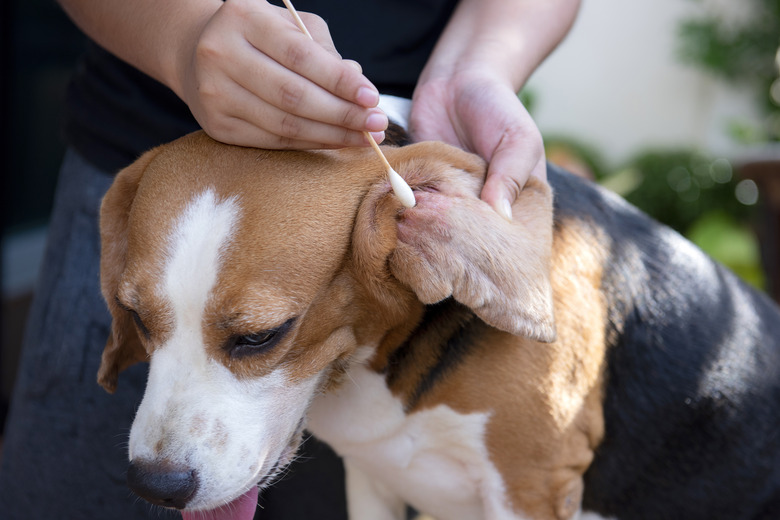My Dog Has White Bumps On His Ear Flap
Dogs can get lesions and lumps on different areas of their body, and the cause isn't always clear. It's best for pet owners to get a veterinarian to examine their dog and decide whether a skin abnormality needs attention, including when a white bump appears on the ear.
Why does my dog have white bumps on their ear?
Why does my dog have white bumps on their ear?
The pinna is part of the outer ear, and it's the part you can see and touch. This area can be affected by various skin conditions. If you notice a white bump on your dog's ear flap, you might start worrying about tumors or abscesses, but it might simply be the result of an insect bite, or it might be a wart, cyst, or aural hematoma, which are a few other examples of the many conditions that could be to blame.
An issue that affects the skin on the ears might also impact other parts of the body, and sometimes, the condition might put your dog at risk of a bacterial infection. Your veterinarian may need to perform a thorough examination to determine the root cause of the symptoms and prescribe the right treatment options.
Insect bites and mites on dog's ears
Insect bites and mites on dog's ears
There are some issues that could cause bumps on the outside or inside of a dog's ear flap but not appear as a problem anywhere else. An example is an insect bite. Insect bites could cause small, pimple-like bumps. Fortunately, bites from insects like flies or mosquitoes typically aren't serious and may only need medication to control itching or inflammation.
Some parasites could lead to symptoms that include swelling and small bumps. A couple examples are fleas and mites, including ear mites, which can cause itchiness and scratching that leads to skin damage. Keep in mind that parasites could be so small and difficult to see that a veterinarian may have to take a skin scraping to make a positive identification. In cases where it's tough to figure out what the problem is, your veterinarian might even request additional tests.
Sebaceous cysts on a dog’s ears
Sebaceous cysts on a dog's ears
Dogs have glands in their skin known as sebaceous glands. These produce an oil called sebum that helps protect the skin. If the sebum ends up clogging the gland, it can lead to a sebaceous cyst, which may look like a small, raised white bump that you can feel beneath your dog's skin.
A sebaceous cyst might form anywhere on a dog's body and can look and feel like a pimple. If this type of cyst develops on the ear, it might be more noticeable because the hair is thinner there.
Aural or ear hematoma in dogs
Aural or ear hematoma in dogs
The ears have many blood vessels. Vigorous shaking, scratching, or an accident or injury can cause some of those blood vessels to burst, leading to bleeding under the skin. This could appear as one or more bumps on the inside of a dog's ear flap, and they might affect a part of the ear or the whole flap.
Hematomas can be painful, and your veterinarian may need to drain them. However, they may eventually disappear on their own as well. Sometimes, the swelling can leave a dog with what's known as "cauliflower ear" from scar tissue.
Excessive scratching and head shaking can have several triggers, such as environmental allergens or food allergies. Your veterinarian can help you figure out the underlying cause of the problem so you can give your dog much-needed relief.
Warts that affect a dog’s ears
Warts that affect a dog's ears
Warts are another reason that you might see bumps on the inside of a dog's ear flap. They are caused by canine papillomavirus, which can be spread from one dog to another, leading to small, misshapen growths on the skin or in the mouth.
A veterinarian can use fine needle aspiration to figure out if a bump on the skin is indeed a wart. Rest assured that if your dog is diagnosed with papillomavirus, you don't need to worry about it spreading to humans.
The bottom line
The bottom line
There are many reasons a dog might develop lumps on their ears. The bumps can be white in color, and they could be on the inside or outside of the ear flap. The cause might be a simple pet health issue, like an inflamed hair follicle or blocked oil glands, or a bump might be a scab caused by an allergic reaction that led to excessive scratching. Other culprits include insect bites, skin parasites, hematomas, cysts, and warts. A DVM can determine what's causing any bumps and provide your pet with the appropriate remedy, whether it's an anti-inflammatory medicine or surgical removal of the lump.


